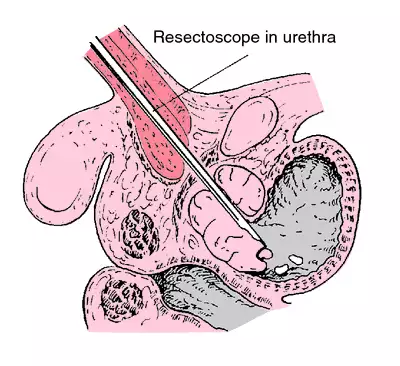Medical term:
transurethral
transurethral
[trans″u-re´thral]performed through the urethra.
transurethral resection of the prostate (TURP) removal of a portion of the prostate by means of an instrument passed through the urethra. A transurethral resection removes only enlarged prostatic tissue, as in benign prostatic hypertrophy. Normal prostatic tissue and its outer capsule are left intact.

Patient Care. Preoperatively the patient will probably have some difficulty in urination, owing to the fact that the prostate encircles the urethra. The patient's fluid intake and output should be measured and recorded, even though he may not have an indwelling catheter to relieve bladder distention from retained urine.
Most patients having this procedure are over the age of 65. A thorough nursing assessment should be done to identify the special needs of the patient, especially those related to chronic illnesses such as heart disease and diabetes, and to such sensory deficits as impaired sight and hearing. Safety measures such as side rails are particularly important, as well as caution in the administration of sedatives and analgesics.
During the immediate postoperative period the patient is monitored for signs of hemorrhage. Drainage through the urinary catheter is expected to be bright red for the first 24 hours after surgery and might upset the patient or someone not familiar with the effects of the surgical procedure. However, an increasingly darker red color could indicate fresh bleeding and should be reported to the surgeon.
In addition, special attention is given to the catheter and tubing leading from the bladder to be sure it is open and draining freely. Severe pain could indicate bladder spasms caused by blood clots and bits of tissue. Before administering any analgesic for relief of bladder pain, the nurse should first note whether the catheter is draining as it should. Irrigations often are prescribed to remove the obstructing material and maintain adequate flow. The irrigation procedure must be done under sterile conditions because infection is a very real danger after prostatectomy. If the patient continues to complain of severe pain even though the bladder is empty, the surgeon should be notified at once, because unusually severe and persistent pain could indicate a perforated bladder.
A transurethral resection does not affect the hormonal level of a male, nor does it render him sterile. After recovery from his surgery he should be able to resume his former level of sexual activity.
Most patients having this procedure are over the age of 65. A thorough nursing assessment should be done to identify the special needs of the patient, especially those related to chronic illnesses such as heart disease and diabetes, and to such sensory deficits as impaired sight and hearing. Safety measures such as side rails are particularly important, as well as caution in the administration of sedatives and analgesics.
During the immediate postoperative period the patient is monitored for signs of hemorrhage. Drainage through the urinary catheter is expected to be bright red for the first 24 hours after surgery and might upset the patient or someone not familiar with the effects of the surgical procedure. However, an increasingly darker red color could indicate fresh bleeding and should be reported to the surgeon.
In addition, special attention is given to the catheter and tubing leading from the bladder to be sure it is open and draining freely. Severe pain could indicate bladder spasms caused by blood clots and bits of tissue. Before administering any analgesic for relief of bladder pain, the nurse should first note whether the catheter is draining as it should. Irrigations often are prescribed to remove the obstructing material and maintain adequate flow. The irrigation procedure must be done under sterile conditions because infection is a very real danger after prostatectomy. If the patient continues to complain of severe pain even though the bladder is empty, the surgeon should be notified at once, because unusually severe and persistent pain could indicate a perforated bladder.
A transurethral resection does not affect the hormonal level of a male, nor does it render him sterile. After recovery from his surgery he should be able to resume his former level of sexual activity.

Transurethral resection of the prostate. Hyperplastic prostate tissue is removed through a resectoscope inserted through the urethra. From Polaski and Tatro, 1996.
Miller-Keane Encyclopedia and Dictionary of Medicine, Nursing, and Allied Health, Seventh Edition. © 2003 by Saunders, an imprint of Elsevier, Inc. All rights reserved.
trans·u·re·thral
(trans'yū-rē'thrăl),Through the urethra.
Farlex Partner Medical Dictionary © Farlex 2012
transurethral
(trăns′yo͝o-rē′thrəl, trănz′-)adj.
Performed through or by way of the urethra: a transurethral resection.
The American Heritage® Medical Dictionary Copyright © 2007, 2004 by Houghton Mifflin Company. Published by Houghton Mifflin Company. All rights reserved.
Word not found in the Dictionary and Encyclopedia. Did you mean:
- transurethral
Latest Searches:
actinomycomata - acthib - acrospire - acrosin - acroscleroderma - acromiothoracic - acromioplasty - acrobystiolith - acrisorcin - AcQtrack - acorea - acoflex - acochoerus - acidogenic - acidity - acidimetries - acidimeter - achillotenotomy - achillodynia - acetylization -
- Service manuals - MBI Corp